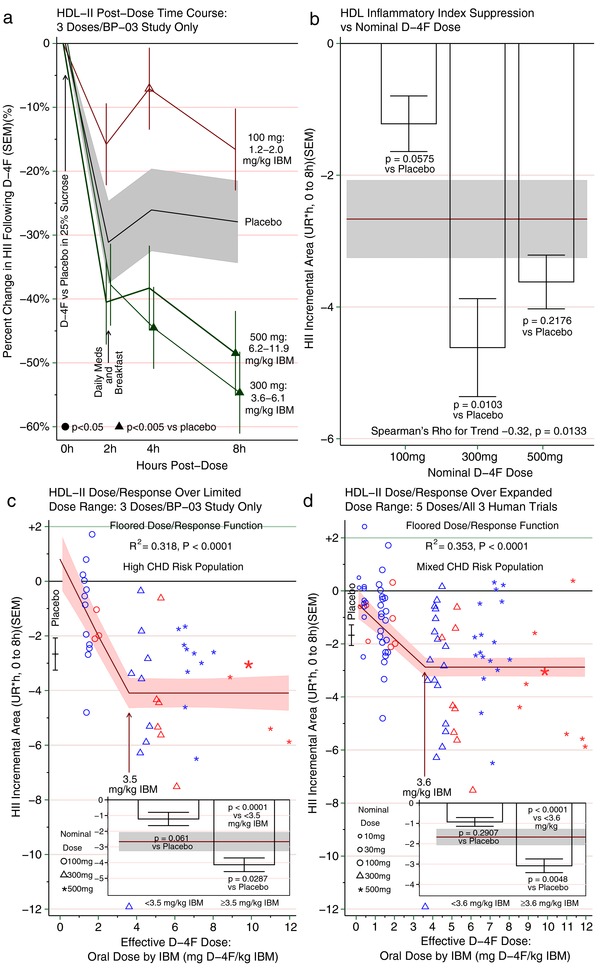Figure 2.

(a) The time course for the change in high‐density lipoprotein (HDL) inflammatory index (HII) is presented over 8 h on day 13 as mean and SEM. Subjects drank D‐4F in a sucrose solution at hour 0, and withheld their usual daily medications and fasted for at least 2 h postdose. By 2 h postdose, HII was uniformly lower than baseline in all groups (i.e., no D‐4F group varied from the placebo group). Then subjects ate breakfast and took their usual medications, including their usual regimen to prevent atherosclerotic vascular disease (ASCVD). Thereafter, higher D‐4F groups ultimately diverged from the placebo group. Among those receiving 300 mg or more of D‐4F, the HII dropped below that of the placebo group at either 4 h or 8 h postdose. In contrast, those receiving 100 mg of D‐4F were no better than placebo, and were even worse than placebo at one point (hour 4). The range for the effective dose of D‐4F is provided as mg D‐4F/ideal body mass (mg/kg). The data from this panel are also shown in Table 4 using various scales, including the absolute scale in unit ratio (UR), change from baseline in UR, and the raw and placebo‐adjusted percent change. (b) The time course curves for each subject on day 13 are presented as HII incremental area under the curve (incAUC 0–8 h), as described in the Methods and illustrated in Supplementary Figure S1. Briefly, the incAUC is the difference between the postdose HII absolute AUC (absAUC) and the predose baseline projected over 8 h (T0 × 8 h). Because the HII typically drops below baseline, the difference (HII absAUC — T0 × 8 h) results in a negative number. A negative HII incAUC is interpreted as HII suppression over 8 h compared to predose HII, that is, a less inflammatory HII. Conversely, a positive HII incAUC would have been interpreted as HII potentiation, that is, a more inflammatory HII. Each subject's incAUC was calculated from HII on its native/absolute scale, the UR; thus, the units for the incAUC are UR*hour over 8 h. We then calculated the mean and SEM of all the individual incAUCs for each group, and present the aggregated HII suppression as incAUC by group. The mean and SEM for the group receiving placebo + ASCVD medications is presented as a horizontal band, and groups receiving D‐4F + ASCVD medications are presented as bars with mean and SEM. The test for trend by nominal dose supported an inverse relationship (rho ‒0.32; P = 0.01), suggesting higher D‐4F doses are generally more apt to render HII less inflammatory than lower doses. That said, the 300 mg and 500 mg doses were not significantly different from each other, suggesting a threshold dose/response relationship rather than a linear relationship. Were a linear relationship operative at the highest dose, one would instead expect the 500 mg dose to vary from the 300 mg, and in the direction of greater HII suppression. Instead, they seem to provide similar HII suppression, more consistent with a flat dose/response relationship. For comparison, the insets within c and d pool the 300 mg and 500 mg dose groups. (c) Dose/response curve between effective D‐4F dose and HII incAUC on day 13 as described in b. The effective D‐4F dose is the nominal D‐4F dose in mg per kg ideal body mass (IBM; mg/kg). As effective dose increased, the HII incAUC declined, consistent with more anti‐inflammatory HDL. This continued until an effective dose of 3.5 mg/kg. At higher effective doses, the dose‐response curve hit a floor, beyond which higher doses did not lower HII incAUC further, as suggested by the similar HII suppression from the 300 mg and 500 mg dose groups in b. A flat/floored dose/response relationship suggests there is a limit to which D‐4F can render HII more anti‐inflammatory rather than continued linear dose responsiveness. For more details on the curve analysis, see Supplementary Table S4. The inset compares HII suppression as incAUC below and above the threshold. Below 3.5 mg/kg, the HII incAUC was numerically worse than placebo, but not significantly so, whereas above 3.5 mg/kg, the HII suppression was significantly improved beyond placebo (P = 0.0287). (d) This panel takes the same approach as c, but expands the dose range by adding two doses in the linear descent portion (10 mg and 30 mg) by combining the day 13 data from c with single‐dose human studies of D‐4F. Doing so enhances the sample size for the 100 mg, 300 mg, and 500 mg doses, augments the number of women, and broadens the population by including subjects whose risk does not exceed the threshold for high ASCVD risk. Again, with increasing effective exposures to D‐4F, HII suppression by incAUC improves to a point, but then flattens out to a floor effect. The data in the inset show that those with effective doses above the threshold have HII that is significantly less inflammatory than those on placebo (P = 0.0048). CHD, coronary heart disease.
